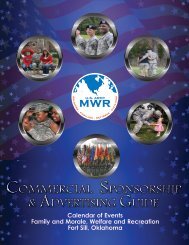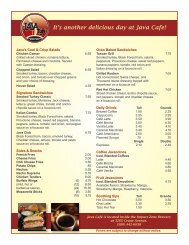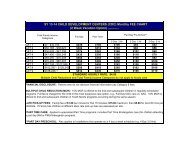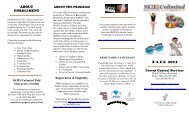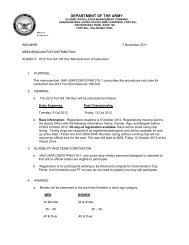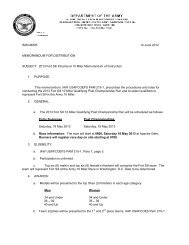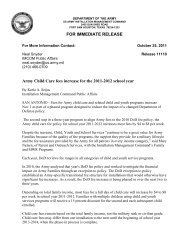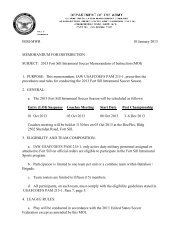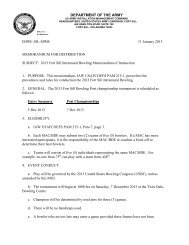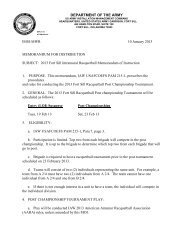Preparing and Managing Correspondence - Fort Sill MWR
Preparing and Managing Correspondence - Fort Sill MWR
Preparing and Managing Correspondence - Fort Sill MWR
You also want an ePaper? Increase the reach of your titles
YUMPU automatically turns print PDFs into web optimized ePapers that Google loves.
c. Limitations. The only time registered, numbered, insured, or certified mail, or certificates of mailing, return<br />
receipts, or restricted delivery may be used is when required by—<br />
(1) Law.<br />
(2) Army regulation.<br />
(3) DOD directive.<br />
(4) Non-DOD governmental agencies with which DA must comply.<br />
5–12. Folding <strong>and</strong> fastening<br />
a. Folding. Fold letters into three parts. Fold the bottom third forward over the text of the letter, <strong>and</strong> fold the top<br />
third back. This conceals the text so it cannot be read <strong>and</strong> still permits the use of window envelopes.<br />
b. Fastening. Fasten a communication of two or more pages, or one containing enclosures, together in the upper left<br />
corner with paper clips or a staple when the correspondence will remain within the headquarters. When the correspondence<br />
is going through the USPS, do not use paper clips, clamps, or similar metal fasteners. When using staples, keep<br />
the number to the minimum needed to fasten papers securely. Place staple in the top left corner of the page. Do not<br />
place staples in the address or text area of a communication. Placing the staples at a 45 degree angle allows the<br />
document to be read more easily <strong>and</strong> makes the pages less prone to tearing when the pages are turned.<br />
5–13. <strong>Preparing</strong> envelopes for mailing<br />
a. Limit or compress a letter-sized envelope, so it does not exceed 1 ⁄4 inch in thickness.<br />
b. Seal each envelope securely. A major cause of automated sorting equipment problems is unsealed flaps on<br />
otherwise acceptable mail pieces.<br />
c. Do not use tape to seal an envelope in lieu of using the glue already on the envelope flap.<br />
d. Do not use heavy tape to seal envelopes. This adds extra weight <strong>and</strong> requires more postage.<br />
e. See AR 380–5 for preparing envelopes containing classified material.<br />
Section IV<br />
Addressing—Format <strong>and</strong> Content<br />
5–14. Addressing<br />
a. If correspondence is for the head of a major department, send it to the individual by title. Some examples are<br />
Secretary, Under Secretary, or an Assistant Secretary of the Army; the Administrative Assistant to the Secretary of the<br />
Army; the General Counsel; Chief of Legislative Liaison; Chief of Public Affairs; or Director, Office of Small <strong>and</strong><br />
Disadvantaged Business Utilization.<br />
b. Use the title of the activity head for correspondence to boards, military missions, commissions, <strong>and</strong> other such<br />
activities.<br />
c. Use titles when addressing correspondence to comm<strong>and</strong>ers or heads of Army field comm<strong>and</strong>s. Route correspondence<br />
to the head of the office involved (by title), but inform intermediate headquarters when necessary.<br />
5–15. Address format<br />
a. Use AR 25–51 to address classified correspondence for North Atlantic Treaty Organization (NATO) comm<strong>and</strong>s.<br />
These instructions pertain to the address on the correspondence <strong>and</strong> the envelope.<br />
b. When addressing military correspondence to an individual by name, show the military grade or civilian prefix,<br />
first name, middle initial (if known), <strong>and</strong> last name in that order. For military personnel, use the following Service<br />
designation abbreviations after the addressee’s name: USA for US Army, USN for US Navy, USAF for US Air Force,<br />
<strong>and</strong> USMC for US Marine Corps.<br />
5–16. Address content<br />
a. General. Make sure addresses are complete <strong>and</strong> accurate, including the ZIP+4 Code. When using an Army Post<br />
Office (APO) or Fleet Post Office (FPO) number, do not show the geographic location of an overseas unit. Identification<br />
of classified overseas units could lead to a breach of security. Moreover, showing the geographic location of such<br />
units increases the cost of postage since senders must pay international postage rates.<br />
b. Addressing for the Address Management System. This information will assist in proper addressing format for<br />
postcards <strong>and</strong> envelopes for the Address Management System (AMS). Proper formats will allow the USPS automated<br />
equipment, optical character readers (OCRs), <strong>and</strong> Personnel Servicing Centers (PSCs) to process Army official mail in<br />
the most accurate <strong>and</strong> efficient manner currently possible.<br />
(1) Mail piece size. In order to be processed by the OCR, mail pieces (postcards <strong>and</strong> envelopes) must be rectangular<br />
<strong>and</strong> must fall within the size st<strong>and</strong>ards prescribed in table 5–1.<br />
(2) Where to place the address. In order to ensure that the OCR reads the mailing address <strong>and</strong> not the return address<br />
(or information not pertaining to the address), an OCR “read area” has been identified. Ensure that the address lines are<br />
parallel with the bottom edge of the mail piece.<br />
44 AR 25–50 • 3 June 2002




